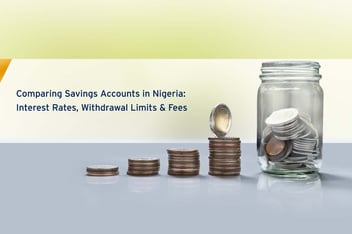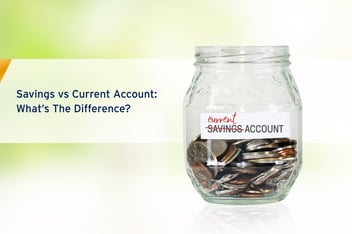
How to Choose the Right Savings Account
When it comes to securing your financial future, selecting the right savings account is a crucial step. With a sea of options available, it's easy to feel overwhelmed and unsure of where to start. In this post, we will walk you through the essential considerations to help you navigate the maze of how to choose the right savings accounts.
A savings account is a deposit account held at a bank or other financial institution that pays interest on the money deposited.
Savings accounts are typically less liquid than current accounts, meaning that there may be restrictions on how often you can withdraw money from the account.
However, savings accounts offer a safe place to store your money and earn interest.
Which type of savings account is right for you?
There are different types of savings accounts and settling for one will depend on your financial goals, needs, and preferences.
Here are some types of savings accounts to consider:
● Basic Savings Account
The Basic Savings Account is the most common and option offered by financial institutions. It provides a secure platform for individuals to deposit and save their money while earning interest. The interest rates for Basic Savings Accounts typically range from 1% to 3% per annum. Although these rates may seem modest, they offer a stable and accessible option for individuals looking to start building their savings or maintain a regular savings routine.
It is a good option if you are just starting to save or want to keep your savings easily accessible.
● High-Yield Savings Account
For those seeking more substantial returns on their savings, the High-Yield Savings Account presents an attractive option. High-Yield Savings Accounts are designed to offer significantly higher interest rates compared to other types of savings' accounts.
These accounts often require higher minimum balances and may have certain eligibility criteria. Interest rates for High-Yield Savings Accounts can range from 5% to 15% per annum or even higher, depending on the financial institution and prevailing market conditions. While these accounts provide the potential for greater returns, it's crucial to carefully assess the terms and conditions to ensure they align with your financial goals and circumstances.
● Money Market Account
A Money Market Account combines the features of a savings account with the benefits of investing in short-term securities. It offers competitive interest rates while providing easy access to funds. The interest rates for Money Market Accounts are typically higher than those of Basic Savings Accounts, ranging from 3% to 8% per annum. These accounts are suitable for you if you’re seeking both liquidity and a potentially higher yield on your savings.
● Certificate of Deposit (CD)
A Certificate of Deposit, or CD, is a time-bound savings option that guarantees a fixed interest rate for a specified period. By agreeing to keep your funds locked in a CD for a predetermined duration, which can vary from a few months to several years, you can enjoy higher interest rates. CD interest rates generally range from 5% to 12% per annum or more, depending on the deposit amount and term length.
● Individual Retirement Account (IRA)
Individual Retirement Accounts are designed for retirement savings. IRAs offer tax advantages and allow your money to grow tax-free, but they have different rules regarding contributions and withdrawals.
They are a good option if you want to save for retirement and take advantage of tax benefits.
How to choose the right savings account
Here are some factors to consider when selecting a savings account:
● Interest rates
The interest rate is a crucial factor as it determines how much your savings will grow over time. Look for accounts with competitive interest rates that can help maximize your earnings. Compare rates offered by different banks and account types to find the most favourable option.
● Fees
Pay attention to any fees or charges associated with the savings account. Common fees include monthly maintenance fees, minimum balance fees, withdrawal fees, and transaction fees. Select an account with minimal fees to avoid eroding your savings.
● Accessibility
Assess how easily you can access your funds. While some accounts offer easy access through ATMs, online banking, or mobile apps, others may have limitations or require advance notice for withdrawals. Consider your liquidity needs and choose an account that provides convenient access to your savings when needed.
● Minimum balance requirements
Some savings accounts require a minimum balance to be maintained. Consider your financial situation and choose an account that aligns with your ability to meet the minimum balance requirement comfortably. Falling below the minimum balance may lead to penalties or a reduction in interest rates.
● Reputation
Choose a savings account from a reputable bank or credit union. Look for online reviews, ratings, and customer feedback to get an idea of the bank's reputation.
● Additional features
Some savings accounts offer additional features such as overdraft protection, bill payment services, or mobile check deposit.
Consider what additional features are important to you and choose an account that meets your needs.
By considering these factors, you can choose a savings account that meets your needs and helps you achieve your financial goals.
Understanding APY and APR in Savings Accounts
APY (Annual Percentage Yield) and APR (Annual Percentage Rate) are two terms that are commonly used to describe the interest rate on savings accounts.
While they may sound similar, there are some important differences between the two.
APY is a measure of the total amount of interest you will earn on your savings account over the course of one year, including any compounding interest.
It takes into account the fact that interest earned on your savings is added to the principal amount, which then earns additional interest.
Usually, APY is higher than APR, and it is the more accurate way of measuring the true return on your savings account.
APR, on the other hand, is a measure of the interest rate you will earn on your savings account without factoring in compounding interest.
It is a simpler measure of the interest rate, and it is often used to compare different savings accounts. However, it does not take into account the fact that interest is added to the principal amount, which means that the actual amount of interest earned may be lower than the APR.
It's important to note that both APY and APR can be affected by fees and other charges associated with the savings account.
For example, a savings account with a high APR but high fees may actually have a lower return than a savings account with a lower APR but no fees.
When comparing savings accounts, it's important to look at both the APY and APR to get a better understanding of the actual return on your savings.
Keep in mind that the interest rate is just one factor to consider when choosing a savings account.
Other factors such as fees, minimum balance requirements, and accessibility should also be taken into account when choosing a savings account.
Now that you know how to choose the right savings account, it's time to take action! Start your research on nairaCompare!
On nairaCompare, you can compare interest rates, evaluate fees, and explore account features that align with your goals. Visit nairaCompare today and find the savings account that is tailored to your needs.
Lessons on personal finance
Personal finance is the management of money and resources in order to achieve individual financial goals.
Personal finance is important because it can help you achieve your financial goals, such as buying a house, retiring comfortably, or saving for your children's education.
Here are some lessons on personal finance:
● Budgeting
Be serious about budgeting. Start by creating a budget to keep track of your income and expenses. This will help you identify areas where you can cut back on spending and save more money.
● Save for emergencies
It is always advised that you build an emergency fund that covers at least three to six months of your expenses. This can help you avoid going into debt in case of unexpected events like job loss or medical emergencies.
● Pay off high-interest debt
Prioritise paying off debts with high-interest rates first. This can help you save money on interest payments and reduce your debt load.
● Invest in retirement
Start investing in retirement as early as possible. Consider contributing to an individual retirement account (IRA) to take advantage of compound interest and save for your future.
● Track your credit score
Your credit score plays a crucial role in your financial life. Make sure to check it regularly and take steps to improve it if necessary.
● Live below your means
Avoid overspending and try to live below your means. This can help you save more money and avoid getting into debt.
● Set financial goals
Set specific financial goals, such as saving for a down payment on a house. This can help you stay motivated and focused on achieving your financial objectives.
Visit nairaCompare to get more information on savings and personal finance.




